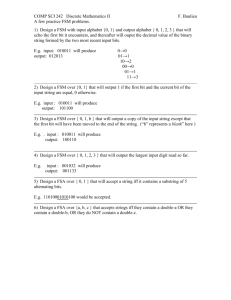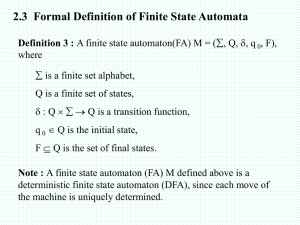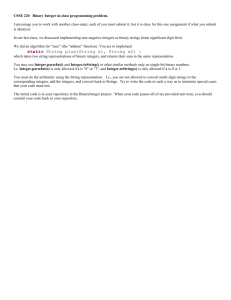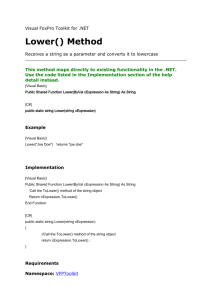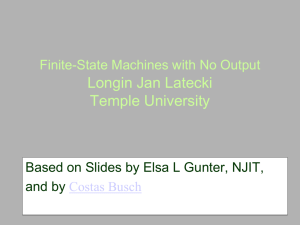Chapter 10: Modeling Computation
advertisement
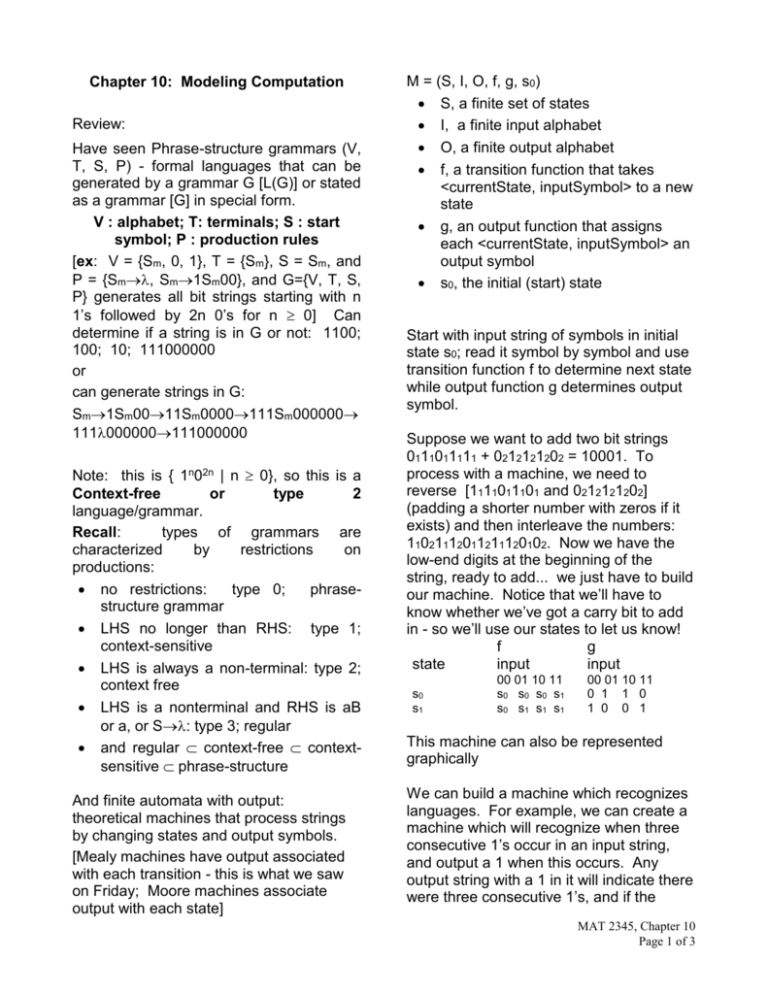
Chapter 10: Modeling Computation
Review:
Have seen Phrase-structure grammars (V,
T, S, P) - formal languages that can be
generated by a grammar G [L(G)] or stated
as a grammar [G] in special form.
V : alphabet; T: terminals; S : start
symbol; P : production rules
[ex: V = {Sm, 0, 1}, T = {Sm}, S = Sm, and
P = {Sm, Sm1Sm00}, and G={V, T, S,
P} generates all bit strings starting with n
1’s followed by 2n 0’s for n 0] Can
determine if a string is in G or not: 1100;
100; 10; 111000000
or
can generate strings in G:
Sm1Sm0011Sm0000111Sm000000
111000000111000000
Note: this is { 1n02n | n 0}, so this is a
Context-free
or
type
2
language/grammar.
Recall:
types of grammars are
characterized
by
restrictions
on
productions:
no restrictions:
type 0;
phrasestructure grammar
LHS no longer than RHS: type 1;
context-sensitive
LHS is always a non-terminal: type 2;
context free
LHS is a nonterminal and RHS is aB
or a, or S: type 3; regular
and regular context-free contextsensitive phrase-structure
And finite automata with output:
theoretical machines that process strings
by changing states and output symbols.
[Mealy machines have output associated
with each transition - this is what we saw
on Friday; Moore machines associate
output with each state]
M = (S, I, O, f, g, s0)
S, a finite set of states
I, a finite input alphabet
O, a finite output alphabet
f, a transition function that takes
<currentState, inputSymbol> to a new
state
g, an output function that assigns
each <currentState, inputSymbol> an
output symbol
s0, the initial (start) state
Start with input string of symbols in initial
state s0; read it symbol by symbol and use
transition function f to determine next state
while output function g determines output
symbol.
Suppose we want to add two bit strings
0111011111 + 0212121202 = 10001. To
process with a machine, we need to
reverse [1111011101 and 0212121202]
(padding a shorter number with zeros if it
exists) and then interleave the numbers:
11021112011211120102. Now we have the
low-end digits at the beginning of the
string, ready to add... we just have to build
our machine. Notice that we’ll have to
know whether we’ve got a carry bit to add
in - so we’ll use our states to let us know!
f
g
state
input
input
s0
s1
00 01 10 11
s0 s0 s0 s1
s0 s1 s1 s1
00 01 10 11
0 1 1 0
1 0 0 1
This machine can also be represented
graphically
We can build a machine which recognizes
languages. For example, we can create a
machine which will recognize when three
consecutive 1’s occur in an input string,
and output a 1 when this occurs. Any
output string with a 1 in it will indicate there
were three consecutive 1’s, and if the
MAT 2345, Chapter 10
Page 1 of 3
output string ends in a 1, there were three
1’s at the end of the input string:
s0 - start
s1 - seen one 1
s2 - seen two 1’s
s3 - seen 3 1’s
Section 10.3: Finite State Machines
with No Output
Recall: Vstar is the set of all strings over
the alphabet V
Definition. If A and B Vstar then the
concatenation of A and B [AB] is the set
of all strings of the form xy where x is a
string in A, and y is a string in B.
Notes: this definition is for SETS of
strings, and that AB may not necessarily
be the same as BA.
Ex: A = {11, 101}, B = {0, 00, 110} then
AB = {110, 1100, 11110, 1010, 10100,
101110}
while
BA = {011, 0101, 0011, 00101, 11011,
110101}.
Definition. An is defined recursively as:
A0 = {} and An+1 = AnA for n 0.
EX: A = {11, 0}, then
A0 = {},
A1 = A0A = A = {11, 0}
A2 = A1A = {11,0}{11,0} =
{1111, 110, 011, 00}
and
A3 = A2A = {1111,110,011,11}{11,0} =
{111111, 11110, 11011, 1100, 01111,
0110, 1111, 110}
Definition. If A Vstar, the Kleene closure
of A [Astar], is the set consisting of
concatenations of arbitrarily many strings
from A. That is, the union as k goes from
0 to infinity of Ak.
EX: Kleene Closures
A = {0}, then A* = {0n | n 0}
B = {0, 1}, then B* = V*, the set of all strings
over the alphabet {0,1}
i.e. = {12n | n 0}
Definition. Finite State Automaton (finite
state machine with no output):
M = (S, I, f, s0, F) consists of
S, a finite set of states
I, a finite input alphabet
f, a transition function from
<currentState, inputSymbol> to
nextState
s0, an initial state
F, a subset of S, the set of final or
accepting states
When we process an input string, symbol
by symbol, beginning in s0 and using f to
go from state to state, if we are left in a
FINAL state at the end of the input string,
then the machine accepts the string.
Definition. A FSA is deterministic if for
each <currentState, inputSymbol> pair
there is a unique nextState given by the
transition function (f). [There is no
“fuzziness” about where we’re going!]
Definition. A FSA is nondeterministic if
there are more than one possible
nextState for each pair of state and input
value.
Definition. A Nondeterministic FSA M =
(S, I, f, s0, F) consists of
S, a set of states
I, an input alphabet
f, a transition function which assigns
<CurrentState, InputSymbol> to a set
of states
s0, a start state
f, a subset of S, consisting of the final
states.
Theorem. NFSA and FSA are equivalent.
I.e., If a language L is recognized by a
NFSA, then L is also recognized by some
FSA.
C = {11}, then Cstar = the set of strings
consisting of an even number of ones,
MAT 2345, Chapter 10
Page 2 of 3
Method for finding the deterministic
equivalent of a nondeterministic machine:
consider combinations of states from
NFSA as states for the FSA.
Section 10.4: Language Recognition
Regular sets can be built up from the null
set, the empty string, and singleton strings
by taking concatenations, unions, and
Kleene closures (all in arbitrary orders).
We will see that Regular sets are exactly
those which are recognizable by FSA.
0 (0 1)* = any string beginning with a 0
(0*1)* = any string not ending in 0 (i.e.,
ends in a 1 or is the empty string)
Kleene’s Theorem. A set is regular IFF it
is recognized by a finite state automaton.
Would have to show:
==> if a set is recognized by a FSA, it is
regular
<== if a set is regular, it is recognized by a
FSA
Definition. The regular expressions
over a set I are defined recursively by:
the symbol is a regular expression;
the symbol is a regular expression;
the symbol x is a regular expression
whenever x I;
the symbols (AB), (AB), and A* are
regular expressions whenever A and B
are regular expressions.
where:
represents the empty set - the set
with no strings
represents the set {}, the set
containing the empty string
x represents the set {x} containing the
string with one symbol, x
(AB) represents the concatenation of
the sets represented by A and by B
(AB) represents the union of the sets
represented by A and by B
A* represents the Kleene closure of
the set represented by A
Sets represented by regular expressions
are called regular sets.
strings in the regular sets specified by
regular expressions:
10* = a 1 followed by any number of 0’s,
including no 0’s
(10)* = any number of copies of 10
(including the null string)
0 01 = the string 0 or the string 01
MAT 2345, Chapter 10
Page 3 of 3


